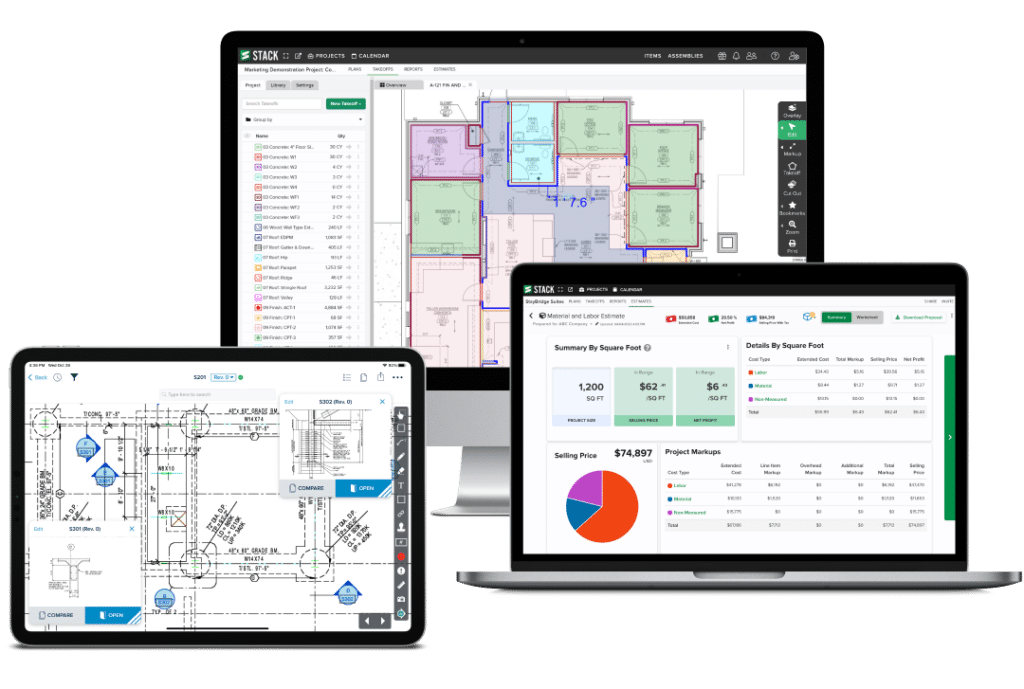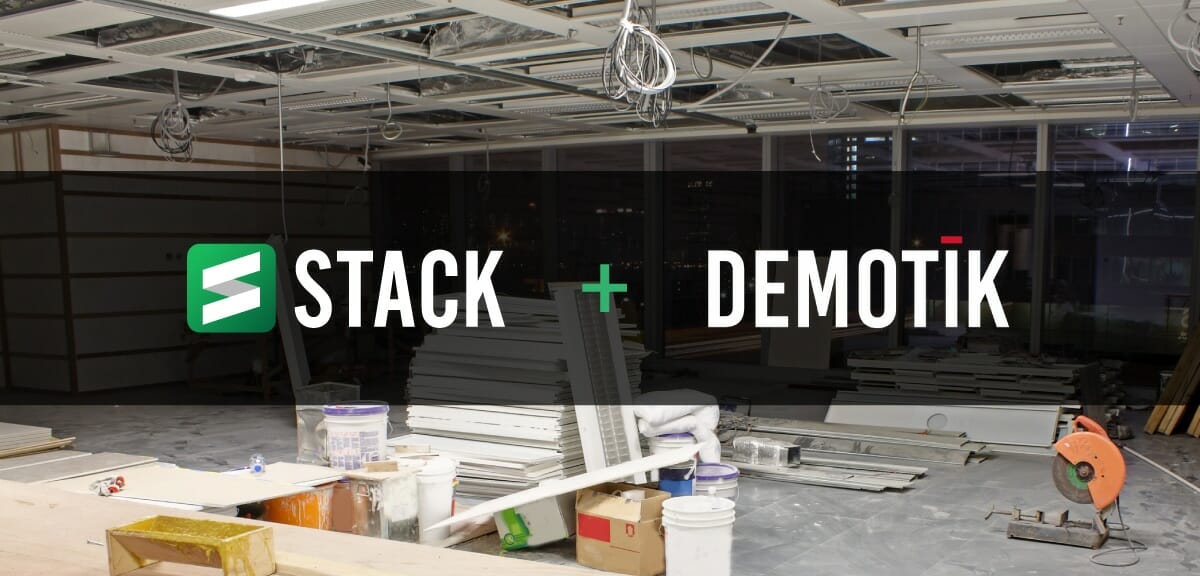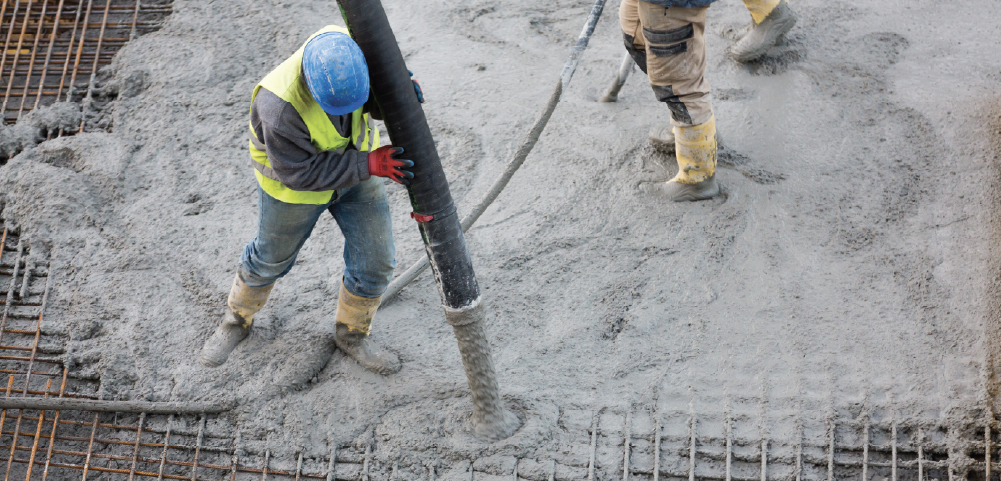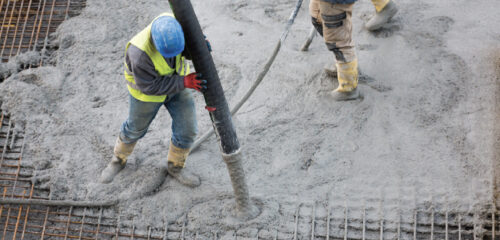STACK’s takeoff and estimating software is made to work for a variety of trades. Here are our tips and tricks for painting contractor software.
7 Main Topics Covered in The Shop Painting Training
1. Plan Page Selection
2. Painting Measurement Types and Takeoff Examples in STACK
3. Time Saver Tools
4. Adding Items & Assemblies
5. Reports, Estimates, & Proposals
6. STACK Tips & Tricks
7. Painting FAQs
Plan Page Selection
For any exterior paint takeoffs you will use the exterior elevation plan page. We’ll walk you through a takeoff measuring for painting exterior brick and a sloped exterior. For any interior paint takeoffs you will focus on floor plans, finish plans, or branding plans. We’ll show you multiple options for interior takeoffs, measuring a ceiling, baseboard, interior walls, and doors.
Painting Measurement Types and Takeoff Examples in STACK
Surface Area, Area-based Takeoff
This is best for interior walls. Surface Area will calculate the total square footage of any wall you measure. Input the Height criteria and start measuring! Use the keyboard shortcut “Shift” key to quickly take the measurement and enable line snapping to 45-, 90-, and 180-degree angles.
Area, Area-based Takeoff
Best for ceilings, exteriors, epoxy floors, and cabinets. In the interior plan example, we’ll show you how to measure a ceiling. On the exterior plans, we are measuring an area to repaint brick. Watch the webinar for a walkthrough!
What if there are windows that need to be removed from the takeoff? We’ve thought of that! Click on the area shape you measured to highlight the shape, then on the righthand tool bar click Cut Out – Cut Rectangle or Keyboard Shortcut “C”. Whether you’re calculating surface area for walls, ceilings, or epoxy floors, using free painting estimate software makes it simple to account for every detail—right down to subtracting windows or doors with a quick ‘Cut Out’ feature.
BONUS: Click the Square icon in the righthand toolbar to quickly measure shapes.
Linear, Linear-based Takeoff
Linear is best for baseboards, crown molding, and trim. Here we’ll measure for a baseboard. In the righthand toolbar, click on the Linear tool.
Count, Count-based Takeoff
Best for doors. Counts are represented by a symbol. The auto-count tool is available to search for a specific symbol in your plans and count each instance. On the righthand toolbar, click Takeoff – Magic Wand and trace around the symbol you want to auto-count.
Pitched Linear, Linear-based Takeoff
This is best for slopes or vaulted ceilings. Here we will measure a sloped exterior section. You will need to input your rise and run before you take the measurement.
Time Saver Tools
Copy
Copy any takeoff to reduce your workload. Click the ellipses next to the takeoff and hit Copy, making sure you rename it. If there are any items or assemblies attached to the original takeoff, that information will be copied as well.
Multiplier
The Multiplier tool will amplify a measurement. Often, you’re painting more than one coat of paint per wall. If you just want the total square footage of a specific wall without any items or assemblies attached, you can click on any measurement and apply a Multiplier. This won’t copy the measurement itself; it only changes the quantity.
Legend Box
This is great for trade-specific content. On the righthand toolbar, click the Markup Tools – Legend Box. Create a box shape and it will include quantities specific to that plan page. You can also hide takeoffs and include specific quantities, like only wall paint or only ceiling paint.
Library
The Library tool hosts global takeoffs so you can access them in multiple projects. Highlight any takeoff, click on the ellipses, and +Library. This attaches the takeoff name, measurement type, color, and any Items and Assemblies. You can search for anything in your Library.
Adding Items & Assemblies
We’ll show you how to work with the Quick Start Item – Interior Eggshell. The unit of measurement and purchase unit is square footage and is set up with a coverage rate. Within an Item you can store pricing within Cost Types (ex: Equipment, Labor, Material, or Custom). You can also list your Accounting Code, SKU #, QuickBooks Online Product & Service (a STACK integration!), and Unit Cost.
Items Grouped Together Become: Assemblies!
Assemblies allow you to answer questions and vary your formula based on the complexity of the project. They allow you to customize any formula within each Item, so you aren’t locked into a coverage rate. Pull in a data point from STACK, add in a variable, and convert to another Purchase Unit.
We’ll show you how to work with the Quick Start Assembly first, Painting – Interior Paint, Area & Surface Area. Within Assemblies there will be Required Items (Primer and Labor) and Item Groups. This Assembly will have every Item needed to build your Interior Paint surface, with Item Group dropdown list options Interior Eggshell, Interior Flat, or Interior Semi-Gloss.
Next, we’ll show you a STACK Assembly – Paint Gyp Walls Surface Area (2021). Your Item Group options are Paint-By-The-Numbers, Choose Paint Crew, Choose Finish Coat, and Choose Primer.
Watch the webinar for more details on copying a template of STACK Assemblies and inputting your own variables to build this Assembly!
BNI Assemblies
There are sample BNI Assemblies available in STACK which are less complex as they focus on cubic yardage or square foot pricing.
Reports, Estimates, & Proposals
All of the Items and Assemblies get translated into the Reports section of STACK. The first three Reports are reserved for Takeoff data – Takeoff Quantity, Takeoff Summary, and Measurements by Takeoff. There are also four Item reports. The purpose of Items is to convert takeoff data into something else – Item List, Item Cost, Item Cost by Type, and Item Cost by Takeoff.
Estimates: Where All Your Takeoff Data Lives
When you work with Items and Assemblies, you’ll use a Material and Labor Estimate. All your measured Items (and the data) become categorized by Cost Type – Crew Hours, Equipment, Labor, Material Costs, etc. Here you can adjust Waste % and Unit Cost if needed. BNI Items pull in regional or national average pricing and plug in the Unit Cost (with separate costs for labor and material). Lastly, you can add in Line Item Markup %, Non-Measured Costs (Equipment, Rentals, etc), Overhead Costs, Additional Markup, and Sales Tax.
On the Summary page of your Material and Labor Estimate you have amazing data points to run your assessments for project pricing. There is a Summary By Key Unit which you can set to Cubic Yard with a profit range for concrete contracting. At the bottom of the page, you can add Scope of Work, Terms and Conditions, customer information, and your logo. Additionally, you can customize your Estimate Summary page by only including specific measurement information from your Takeoffs, Plan Names, Cost Types, or Labels.
While recommended best practice is to keep all of your data in the STACK platform and create detailed estimates and proposals directly from your takeoff information, we recognize that not every estimator works the same way. STACK offers three other ways to Estimate – Export Reports, Excel Plug-In, and STACK’s open API.
And Finally...Proposals!
You’re able to choose a basic view of Proposal with a Summary Page or share additional Line Item Details customized to your liking (Selling Price, Unit Price, Quantity, Takeoff Description).
Bid Faster. Win More. Build Smarter.
Get your FREE account today to:
- Increase Team Efficiency
- Complete Estimates Faster
- Generate More Revenue

STACK Tips & Tricks
– Snapshot Button – a great way to lock in data at that moment. It is a point of reference and backup for when you originally priced the project with a time and date stamp.
– STACK’s Takeoff Library has pre-built Assemblies.
– You can hide and unhide any takeoffs with the eyeball icon so you can see the measurements you want on the plans.
– Bookmark tool – Add bookmarks to plan pages to follow links to details and schedules. This allows you to get around STACK and find data instantaneously.
– STACK automatically hyperlinks page names to help you find your data quickly.
Painting FAQs
Q: Is there a way to show you painted multiple coats of paint or primer?
A: If you want to see multiple coats of paint or primer, you’re going to create that variable in a custom formula in an Assembly. You can use a fixed number of coats or ask for a number to complete the formula.
Q: How can I specify how the paint was applied, for example by roller, brushing, or spray?
A: You can create Items for the different ways you apply paint. We have a prebuilt STACK Assembly – Paint Walls & Trim, Linear – that shows an example of this.
Additional Painting Resources
The best part about this webinar series? You can review at your own pace! Watch the webinar, review our Online Help Guide with great articles and tutorials, use Live Chat within STACK, and review the Painting Quick Reference guide below. STACK always encourages you to continue your education on our platform through Training!








